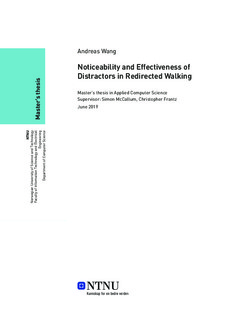| dc.description.abstract | Redirected walking is an area of VR research that aims to optimise the usage of physical tracking space. This optimisation is handled by doing small manipulations to the camera of the user, so they effectively are redirected away from physical walls as they move around in a room scale VR experience.
A sub-field within redirected walking is the topic of virtual distractors. These are objects or abstract elements that occupy the attention of the user in a way that facilitates redirection. A problem that current day distractors aim to mitigate is to improve the user's subjective sense of presence and immersion. This problem is handled by fully integrating them into virtual experiences, so they become an essential part of it, rather than some auxiliary tool. Despite this solution, the field is relatively young and current research is currently at the tip of an iceberg in a larger space of inquiry.
In order to increase our understanding of this area of research, this thesis has employed an exploratory approach and developed a VR game titled ''Ensemble Retriever'', which makes use of state of the art distractors. As part of the work, a new redirection algorithm has been developed: ''Align Centre to Future'' (AC2F) which uses distractors to align the user's future path towards the centre of their physical space. In conjunction with AC2F, a new reset technique: ''Pause - Turn - Centre'' has been developed to deal with the various shortcomings of existing reset methods.
By using Ensemble Retriever, two experiments have been conducted to gain deeper insights into various factors on noticeability and effectiveness of distractors in redirected walking. The first of these focused on testing whether there were any significant differences in detection thresholds between two states of Ensemble Retriever: a general walking state and a battle state against an enemy distractor. No significant difference was found for positive rotation gains. Despite these results, it was significantly easier to detect negative rotation gains during distractor battles. Furthermore, an adaptation effect towards positive rotation gains was observed.
The second experiment focused on assessing the effectiveness of the AC2F algorithm. In this case, two conditions were compared: one where the commonly used ''Steer to Center'' (S2C) algorithm was employed when walking and AC2F when interacting with distractors. The other condition used S2C for everything. The results showed no significant difference between the conditions in terms of the mean number of resets or the mean time needed to align the user's future path towards the centre of the physical space. Despite these results, the first condition resulted in 15.8% fewer failure cases in terms of successful alignments towards physical room centre.
The overall results and discussions around these have yielded a large pool of future work which could be seen as pathways that can be taken to expand our knowledge within the field of distractors and redirected walking as a whole. In addition, Ensemble Retriever and its corresponding source code is openly available for other researchers and developers to see and use. | |
